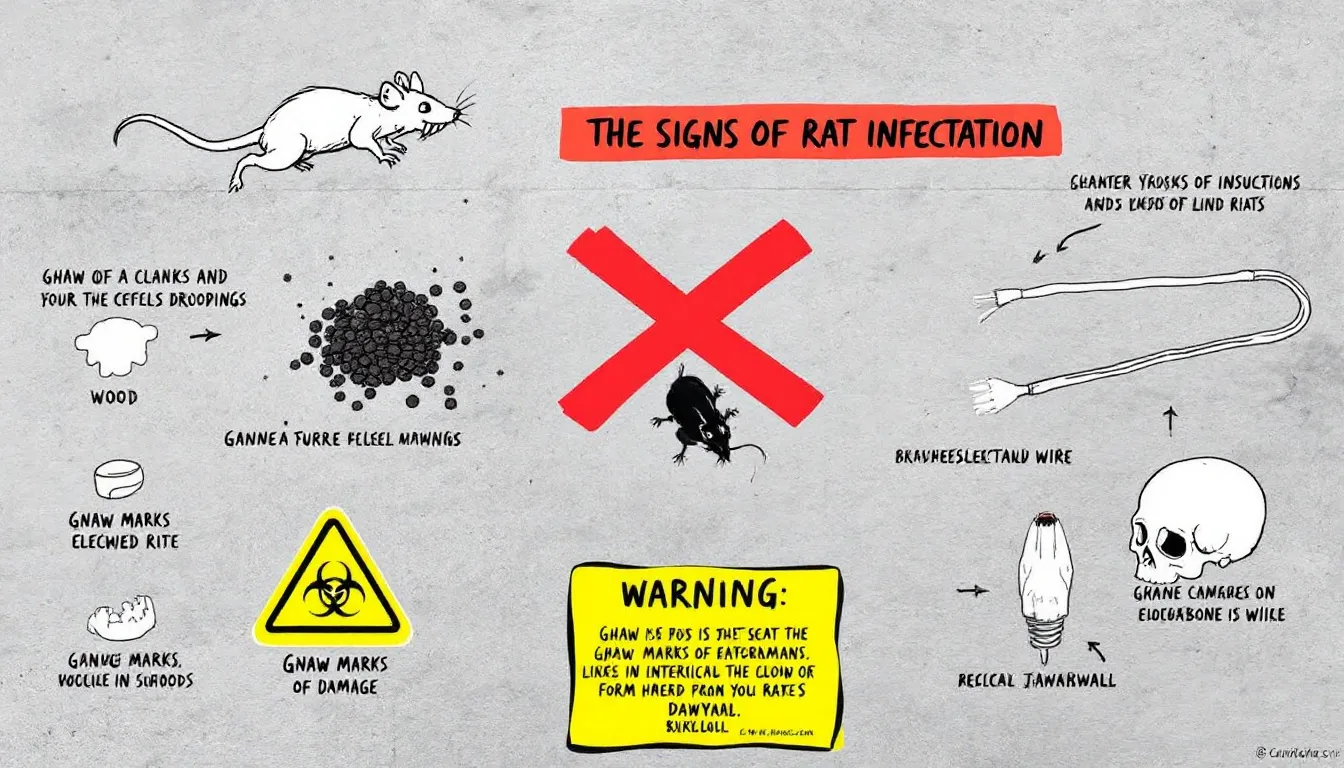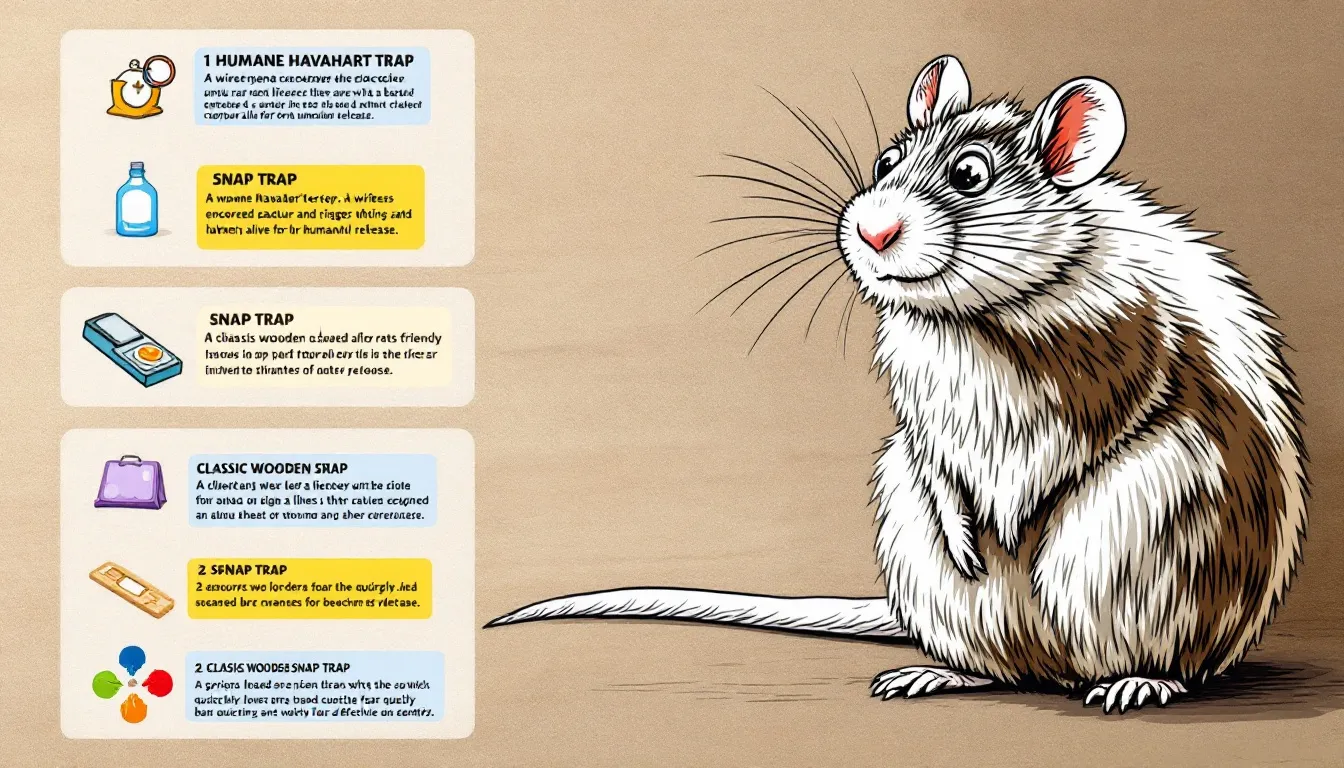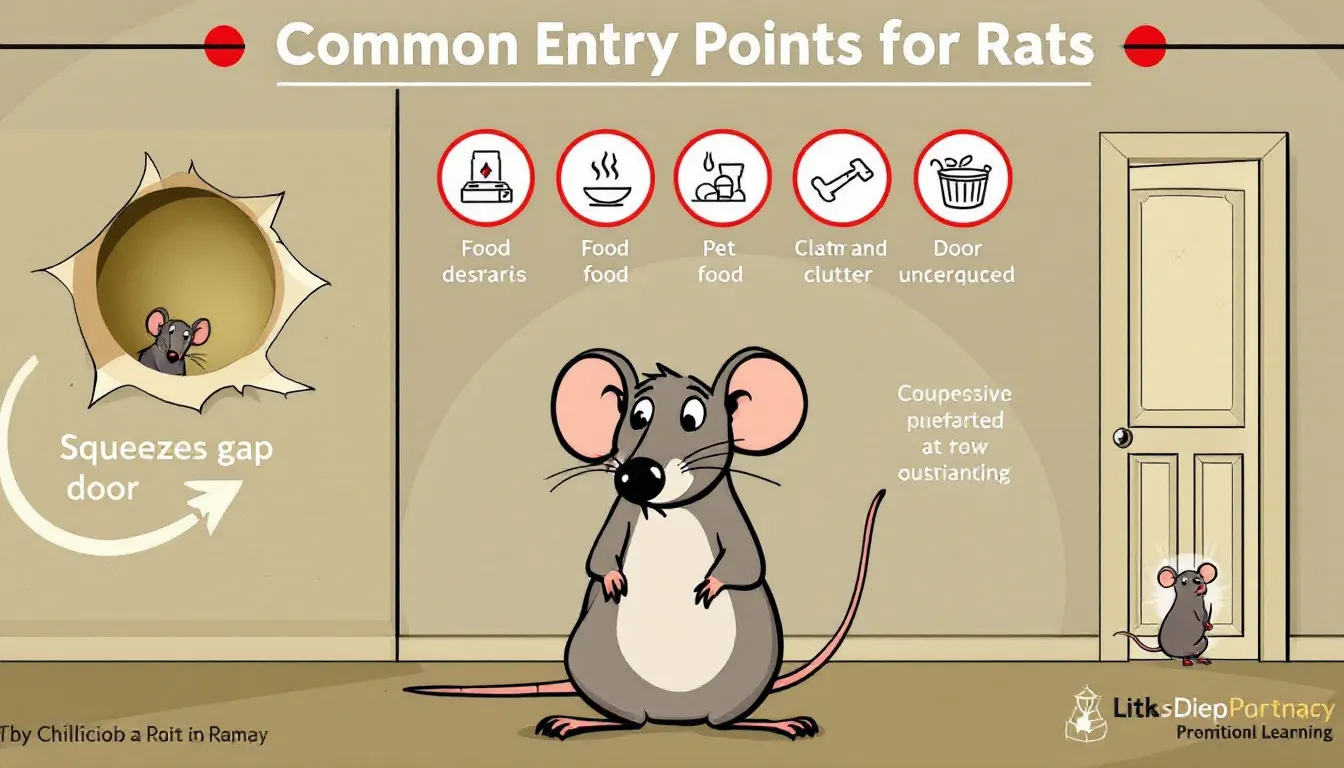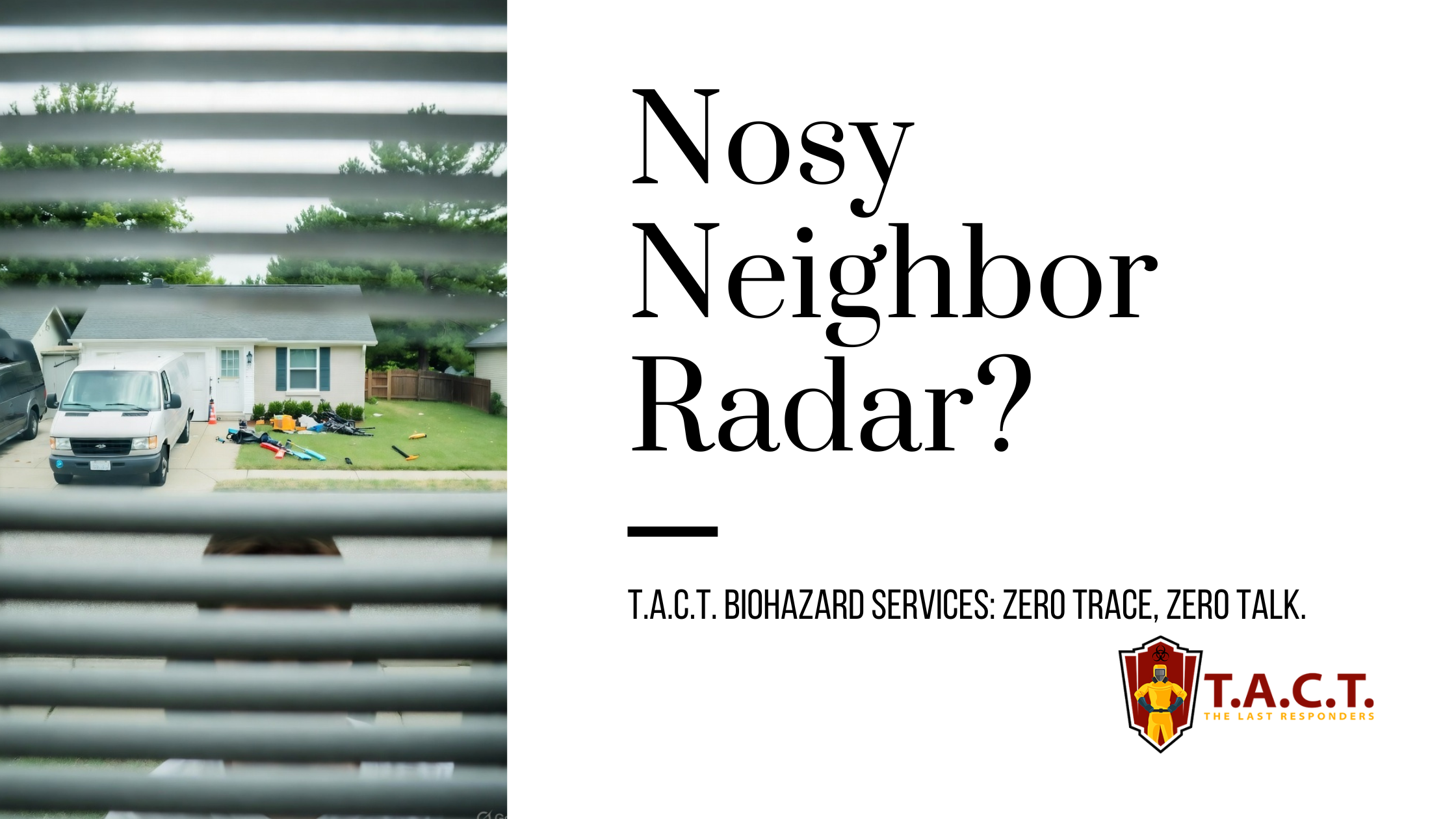Rat Pest Removal

Effective Rat Pest Removal: Best Methods and Tips
Struggling with a rat infestation in your home? Rat pest removal starts with identifying the problem and taking swift action. In this guide, learn how to spot the signs of rats, effective removal methods, and essential tips for preventing future infestations.
Key Takeaways
Identifying signs of rat infestations, such as droppings, gnaw marks, and noises, is crucial for early detection and effective removal.
Professional rat removal services provide comprehensive inspections and tailored treatment plans, ensuring effective and safe pest control compared to DIY methods.
Implementing preventive measures, including sealing entry points, maintaining cleanliness, and addressing food and water sources, is essential to minimize future rat infestations.
Identifying Signs of a Rat Infestation

The first step in dealing with a rat infestation is to know what to look for. Rats, like other rodents, leave behind telltale signs that can alert you to their presence. One of the most common indicators is the presence of droppings. If you notice small, dark pellets scattered around your home, especially near food sources or along walls, you might have a rodent problem. Another clear sign is gnaw marks on wood, plastic, and other materials as rats create pathways and access points.
In addition to visible signs, your senses can also provide clues. Rats often produce scratching or rustling noises at night, as they are nocturnal creatures. If you hear unexplained noises in the walls or attic, it’s a strong indication of rat activity. Furthermore, rats leave behind a distinctive musky odor from their urine, which can become quite pungent if the infestation is severe. This smell is often one of the first things homeowners notice, and the odors can be quite strong.
Confirm your suspicions by conducting a thorough inspection of your home. Use a flashlight to check dark, hidden areas where rodents typically hide, such as behind appliances, in the attic, or in the basement. Look for nests made from shredded paper or fabric, as these are common in areas where rats live and breed. Regular monitoring and inspection are crucial because early detection can significantly improve the effectiveness of your removal efforts.
Continuous monitoring is important. Even if you don’t find any immediate signs, watch for new droppings or chewed materials. These indicators can help you catch infestations early, before they become a severe problem with birds and bites.
First Steps to Take When You Suspect Rats
Once you suspect a rat infestation, swift and decisive action is necessary. The first step is to seal any potential entry points to prevent further access. Damaged soffits, fascia, and gaps under doors can all serve as gateways for rodents. Installing door sweeps and repairing any structural damage can greatly reduce the risk of rats entering your home.
Next, address potential attractants inside your home. Store food in sealed containers and make sure to dispose of trash regularly to minimize the availability of food sources. Rats are opportunistic feeders and will be drawn to any easily accessible food. Keeping your home clean and food properly stored reduces the chances of attracting rodents.
Lastly, eliminate water sources around your property. Fix any leaking pipes or faucets, as these can provide the moisture that rats need to survive. Regularly check for standing water and ensure that your home’s plumbing is in good repair. Removing these essential resources makes your home less appealing to these unwelcome guests.
Professional Rat Removal Services
While taking initial steps can help, professional rat removal services are often necessary for thorough and effective pest control. Professional exterminators start with a comprehensive home inspection to identify entry points and nesting sites, which is crucial for effective rodent control. They use their expertise to understand rat behavior and implement safe and targeted trapping strategies, minimizing risks to humans and pets.
After the inspection, professionals create personalized treatment plans tailored to the specific needs of your house and the trees around it, considering your home’s structure. This customized approach ensures that the methods used are effective and suitable for your particular situation. Reputable services also focus on environmentally friendly methods and provide guarantees, which can give you peace of mind that the problem will be handled sustainably and thoroughly.
Moreover, professional services often offer long-term prevention solutions to ensure that rats do not return. This includes sealing entry points, advising on proper sanitation practices, and sometimes even follow-up visits to monitor the situation. Investing in professional pest control saves time, reduces costs, and achieves more reliable results compared to DIY attempts.
Effective Trapping Methods for Rats

Effective trapping is a key component of any rat removal strategy. The first step is to determine the type of rodent you’re dealing with, as this will influence the choice of traps and bait. For example, black rats prefer peanut butter, while brown rats, such as Norway rats, are more attracted to smelly cheese. Using the right bait can significantly increase the chances of catching these pests.
Strategic placement of traps is also crucial. Placing traps at a 90-degree angle against walls, with the trigger side facing the wall, can increase effectiveness since rats tend to move along walls. Initially, it’s a good idea to place traps without bait to let the rats get accustomed to them. Once they are familiar with the traps, you can then set them with bait to catch the rodents.
In some cases, electronic traps might be the best option. These traps can kill rats instantly and don’t require any bait, making them convenient for indoor use. For larger infestations, it’s essential to place multiple traps throughout the property to increase the chances of catching all the rats. This approach ensures that you address the entire population rather than just a few individuals.
Monitoring rodent activity is vital for adjusting your trapping strategies. Set traps in areas where rodent activity is suspected, such as near nests or along their trails. Monitoring where you’re having the most success allows you to adapt your methods for greater effectiveness over time.
Preventing Future Rat Infestations

Prevention is always better than cure, and this certainly applies to rat infestations. After dealing with an infestation, implementing preventive measures can help block entry points and reduce the likelihood of future infestations. Regularly inspect your home for any cracks or gaps, particularly around doors and windows, and seal them using durable materials like steel wool or caulk. Installing door sweeps can also help prevent rodents from entering your home.
Natural deterrents can be part of your strategy. Peppermint oil, for example, is known to repel rodents and can be used in combination with other methods. Additionally, trimming back tree branches that are close to your roof can prevent roof rats from accessing your home, and maintaining a clean, clutter-free environment inside your home can minimize hiding spots for these pests.
Proper food storage and sanitation are critical. Store food in airtight containers and clean up crumbs promptly to reduce food availability for rodents. Regularly check for and fix any leaks or standing water near your home. Keeping your living areas tidy and free from clutter makes it much harder for rodents to find places to nest and sources of food.
The Risks of DIY Rat Removal
Many homeowners might be tempted to tackle rat problems on their own, but DIY rat removal carries significant risks. These methods can be frustrating and time-consuming, often resulting in techniques that do not work. DIY efforts typically fail to address the underlying causes of an infestation, which minimizes their effectiveness. Homeowners might overlook hidden nests, allowing the infestation to persist and even worsen.
Moreover, attempting to remove rats without professional help can lead to wasted time, money, and effort, which can make the situation worse. In contrast, hiring professionals can save time and reduce cost, as they use proven methods and have the expertise to manage the problem effectively.
The risks associated with DIY methods, including potential exposure to diseases and improper use of traps or baits, make professional pest control a safer and more reliable option.
Why Rats Are Attracted to Your Home
Understanding why rats are attracted to your home can help you implement effective preventive measures. Rats are primarily drawn to homes by the availability of food. Open pet food containers, unsecured pantry items, and improperly sealed trash can all attract these opportunistic feeders. By securing food sources, you can reduce the likelihood of attracting rodents and attract rodents.
Cluttered areas inside and outside your home provide the perfect environments for rats to nest. Attics, garages, and basements that are full of clutter offer warm, secluded nesting areas that are appealing to rats. Similarly, outdoor clutter, such as piles of leaves and overgrown vegetation, offers hiding spots that make it easier for rats to establish themselves near your home.
Water sources are another major attractant. Leaky pipes, pet water bowls left outside, and other water sources can draw rats to your property. By addressing these issues, you can make your home less appealing to these pests and reduce the chances of an infestation.
Health Risks Posed by Rats

Rodent infestations pose significant health risks due to the diseases they can transmit and the property damage they cause. Rats and mice can carry and transmit hantavirus to humans, primarily through exposure to their droppings, urine, and saliva. Symptoms of hantavirus infection include fever, muscle pain, and respiratory difficulties, which can escalate to severe lung issues.
The risk of hantavirus infection is heightened in environments with active rodent infestations and poorly ventilated spaces. Engaging in DIY rat removal can expose individuals to these serious health risks, as well as potential harm to pets due to bad toxic baits or unsecured traps that can contaminate the environment.
Professional pest control services are essential for ensuring the safe and effective removal of rats, thereby reducing health risks. By relying on experts, you can protect your health and your home from the dangers posed by rodent infestations.
Maintaining a Rodent-Free Environment
Ongoing maintenance is crucial for preventing rat infestations, as it helps to rid your infested home of potential attractants and vulnerabilities in life, including those that might attract a mouse at an entry point on the ground.
Here are some key steps to follow:
Regularly inspect your property and perform necessary repairs to address any gaps or weak points that could allow rats to enter.
Utilize exclusion techniques such as sealing up holes.
Maintain clean outdoor areas.
Practice proper food storage to deter rats.
By following these steps, you can significantly reduce the risk of a rat infestation in your home.
By implementing ongoing maintenance and exclusion strategies, you can significantly reduce the risk of future rat infestations and protect your home. Consistent vigilance and proactive measures are key to maintaining a rodent-free environment, ensuring that your home remains safe and secure from these persistent pests.
Summary
In summary, effective rat pest removal requires a combination of early detection, immediate action, professional intervention, and ongoing preventive measures. By understanding the signs of an infestation, taking swift steps to eliminate attractants, and relying on professional services, you can successfully rid your home of rats and prevent their return. Remember, maintaining a clean and secure environment is crucial for keeping these unwelcome guests at bay. Take charge of your home’s safety and enjoy peace of mind knowing that you are well-prepared to handle any rat infestation.
Frequently Asked Questions
What are the most common signs of a rat infestation?
The most common signs of a rat infestation are droppings, gnaw marks, scratching noises, musky odors, and nests made from shredded materials. Promptly addressing these signs can help prevent more significant issues.
What immediate steps should I take if I suspect rats in my home?
If you suspect rats in your home, immediately seal entry points, store food in sealed containers, dispose of trash regularly, and eliminate any water sources. Taking these steps promptly can help prevent an infestation.
Why should I hire professional rat removal services?
Hiring professional rat removal services ensures thorough inspections, personalized treatment plans, and long-term prevention strategies that are more effective and safer than DIY methods. This approach minimizes health risks and promotes a pest-free environment.
How can I prevent future rat infestations?
To prevent future rat infestations, regularly inspect and seal gaps in your home, maintain a clean environment, and store food properly. Utilizing natural deterrents like peppermint oil can also be effective.
What health risks do rats pose?
Rats pose significant health risks by transmitting diseases like hantavirus through their droppings, urine, and saliva, leading to symptoms such as fever, muscle pain, and respiratory issues. Engaging professional pest control is essential to mitigate these risks effectively.
Latest news

Nosy neighbors peeking? T.A.C.T. North Atlanta offers discreet biohazard remediation for rodent infestations, mold, hoarding, and more. Unmarked vehicles, quiet experts, full privacy—24/7 service at 470-781-4775.
Read More

